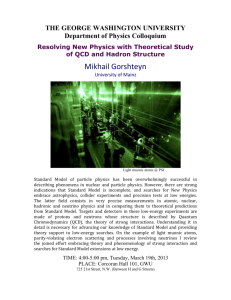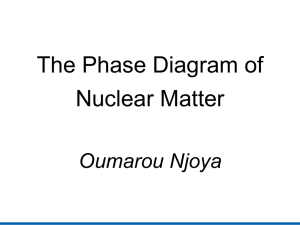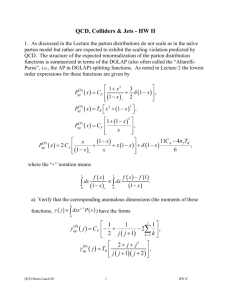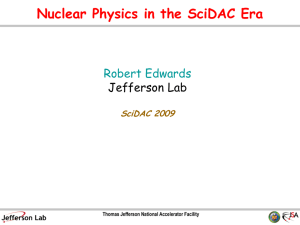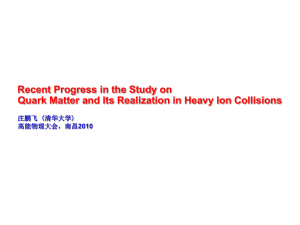The Orientation of the QCD Vacuum
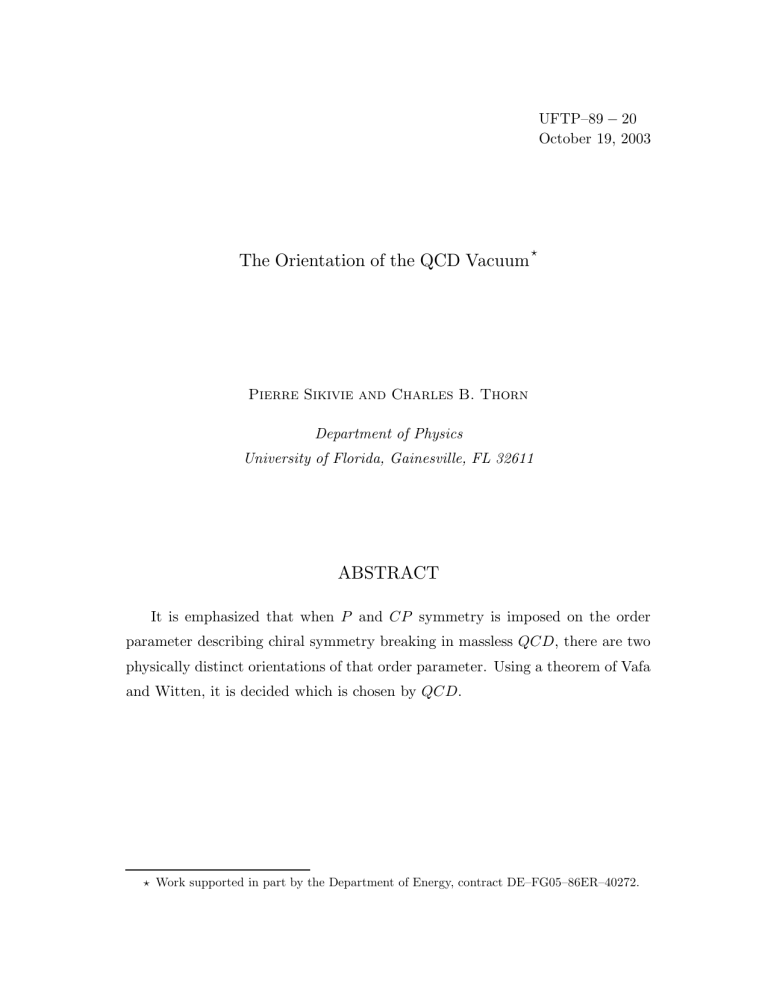
The Orientation of the QCD Vacuum
?
UFTP–89 − 20
October 19, 2003
Pierre Sikivie and Charles B. Thorn
Department of Physics
University of Florida, Gainesville, FL 32611
ABSTRACT
It is emphasized that when P and CP symmetry is imposed on the order parameter describing chiral symmetry breaking in massless QCD , there are two physically distinct orientations of that order parameter. Using a theorem of Vafa and Witten, it is decided which is chosen by QCD .
?
Work supported in part by the Department of Energy, contract DE–FG05–86ER–40272.
Although QCD is generally believed to be the correct theory of the strong interactions, there is as yet no thorough understanding of its nonperturbative aspects—in spite of the fact that it is precisely these aspects which play the crucial role in most manifestations of the strong force. As a result any theorems about nonperturbative properties of QCD , e.g.
the anomaly constraints of ‘t Hooft,
[1] are especially valuable. A particularly strong result of this kind was obtained a few years ago by Vafa and Witten.
[2]
They prove, using the positivity of the Euclidean path integrand for Yang-Mills theory, that QCD does not spontaneously break parity if ¯ = 0. In addition, they show that the vacuum energy density has its minimum value at ¯ = 0. In this note we clarify what this theorem tells us about the vacuum of QCD .
Let us assume that QCD , with N f
(usually one takes N f
= 2 or 3) massless quarks and with the electroweak interactions turned off, breaks chiral
SU ( N f
) × SU ( N f
) to SU ( N f
), so that the quark-antiquark condensate L i R j
0 is proportional to a unitary N f
× N f matrix i R j
0
= µ 3 U j
0 i , (1) with µ of order the QCD scale. An SU ( N f
) × SU ( N f
) transformation changes the orientation of U 0 but cannot change its determinant, so it is convenient to write
U 0 = e iγ/N f U (2) with det U = 1. Here we define γ at θ = 0, where θ enters the coefficient of F in the QCD lagrangian. Of course, physics is independent of θ in massless QCD .
Thus if we set θ = 0 by a redefinition of the phases of quark fields, U 0 would be exp { i ( γ + θ ) /N f
} U .
The parameter γ , defined modulo 2 π , is a fundamental property of QCD . In particular, its nonvanishing generally signifies spontaneous breakdown of P and
CP . However, imposing P and CP invariance does not uniquely specify γ : it
2
only implies γ = 0 or γ = π . To see this, note that under the standard definitions of P and CP
P
CP
:
:
L i R j
L i R j
→
→
R i L j
R j L i
=
= i R k i R k e − 2 iγ/N f U † 2 k j e − 2 iγ/N f ( U † U ∗ ) k j
.
(3)
Thus invariance under these transformations requires
U
† 2 k j
= ( U
†
U
∗
) k j
= e 2 iγ/N f δ k j
, which implies γ = 0 or π (since det U = 1) and also puts restrictions on U . Since
SU ( N f
) × SU ( N f
) is an exact invariance of QCD with N f massless quarks, it is possible in that case to modify P and CP by a chiral transformation to make them invariances of the vacuum without any restriction on U .
?
The two P and
CP conserving values of γ are physically inequivalent (an SU ( N f
) × SU ( N f
) transformation on the quark fields can not interchange them), and the one that is chosen depends on the theory. One choice or the other is realized in QCD , but which?
Appealing to the phenomenology of the pseudoscalar mass spectrum doesn’t settle this question. The well-known Gell-Mann Oakes Renner analysis
[3] determines the pseudoscalar masses in chiral perturbation theory in terms of the products m i
U i
0 i = m i exp { i ( γ + ¯ ) /N f
} U i i (4) where we have chosen the quark mass matrix diagonal with positive entries. The vacuum angle with these sign conventions on the mass matrix is traditionally
?
If SU ( N f
) × SU ( N f
) is explicitly broken, e.g.
by giving masses to the quarks, the restrictions on U matter. For example, if all N
Lagrangian retains a diagonal SU ( N f f quarks have the same nonzero mass (so that the
) invariance), and if ¯ = 0, γ = π , and N f is even , then the restrictions on U imposed by P and/or CP invariance are inconsistent with diagonal
SU ( N f
) invariance of the vacuum: there would then be massless Goldstone bosons due to the spontaneous breaking of this symmetry.
3
denoted ¯ . Thus pseudoscalar mass phenomenology determines only the sum
γ + ¯ . The usual successful mass predictions in the case of three flavors N f
= 3 require γ + ¯ = π . Note that this revises the usual statement that successful mass relations require ¯ = 0.
For general N f
, independently of any phenomenological considerations, one can consider the first order shift of the vacuum energy in chiral perturbation theory h H ( U 0 ) i = µ 3 Tr[ e i ( γ +¯ ) /N f U M + h.c.
] , (5) as a function of U and ¯ . Here M = diag { m
1
, m
2
, . . . , m
N f
} is the quark mass matrix, chosen with positive entries. It is not hard to show that the absolute minimum of this expression as a function of ¯ and U occurs for γ + ¯ = N f
π mod 2 π . Thus for an odd number of flavors we have the minimum occurring at
γ + ¯ = π , whereas for an even number of flavors, this happens at γ θ = 0.
Returning to phenomenology ( N f
= 3) we see that in models, such as axion models, where ¯ is dynamical and so assumes the value that minimizes the energy, the successful mass predictions apply if chiral perturbation theory is valid, even if CP is spontaneously broken by a value of γ = 0 or π . If P and CP are imposed
(this limits the values of γ and ¯ to 0 or π ), one gets successful pseudoscalar mass phenomenology in two physically distinct situations: ( γ,
¯
) = (0 , π ) or ( π, 0). The other two CP conserving situations (( γ , ¯ ) = (0 , 0) or ( π, π )) give poor predictions for the pseudoscalar masses, in the sense of Ref.[4]. It seems a difficult matter to determine γ and θ separately from phenomenology (at least in the absence of a rigorous treatment of the nonperturbative aspects of QCD ).
But the matter is settled theoretically by applying the work of Vafa and
Witten,
[2] in which they show that QCD with ¯ = 0 does not spontaneously break parity. They also show that the vacuum energy achieves its minimum value, as a function of ¯ θ = 0. Combining this with the first order chiral perturbation theory result, described above, that for small positive quark masses the vacuum
4
energy is minimized at ¯ + γ = N f
π , we learn that for massless QCD , γ = N f
π .
Indeed, if γ were ( N f
− 1) π then, in the case of small positive quark masses, the vacuum energy at ¯ θ = π .
The same result (for the case N f
= 3) can be obtained as a corollary to the
Vafa-Witten parity conservation theorem by noting that if γ were zero, then one would have spontaneous P and CP violation at ¯ = 0 for certain ratios of the three light quark masses, in the manner first pointed out by Dashen.
[5]
This would be in contradiction to the theorem.
In conclusion, the condition under which good (poor) pseudo-scalar mass relations are obtained is γ + ¯ = π ( γ + ¯ = 0), instead of ¯ θ = π ) as is usually stated. Of course, since one can infer from the above arguments that γ = π , the usual assertion is not in error after all, but it does require the additional theoretical input provided by the Vafa-Witten theorem.
Acknowledgements: We thank S. Coleman for stimulating our interest in this issue. We also thank C. Vafa, for insightful comments. This work was supported in part by the U. S. Department of Energy under contract number DE-FG05-
86ER-40272.
References
1. G. ‘t Hooft, in Recent Developments in Gauge Theories , G. ‘t Hooft et al ,
Eds. (Plenum, New York, 1980).
2. C. Vafa and E. Witten, Phys. Rev. Lett.
53 (1984) 535.
3. M. Gell-Mann, R. J. Oakes, and B. Renner, Phys. Rev.
175 (1968) 2195.
4. R. J. Crewther, P. diVecchia, G. Veneziano, and E. Witten, Phys. Lett.
88B (1979) 123.
5. R. Dashen, Phys. Rev.
D3 (1971) 1879.
5

